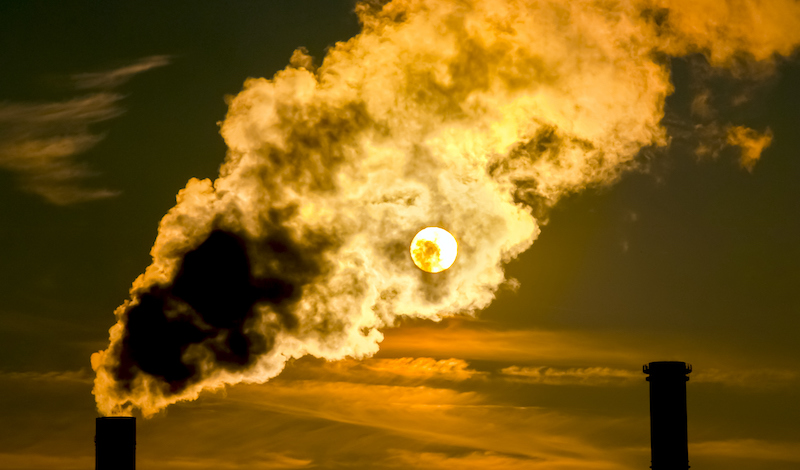
The Biden Administration seeks to require the oil and gas industry to find and fix their own methane leaks.
Methane emissions are the second-largest cause of climate change after carbon dioxide, and the oil and gas industry contributes roughly a third of those methane emissions globally. As a result, the U.S. Environmental Protection Agency (EPA) is now seeking to strengthen its regulations on the industry’s leaks of methane from their wells, pipes, and equipment.
Under an updated proposal announced on November 11, EPA would require all oil and gas sites in the country—old and new, big and small—to monitor their emissions, identify causes of major leaks, and take corrective action.
The agency initially broached the issue of methane pollution in the oil and gas industry last year. In a proposed rule issued then, EPA sought, for the first time in its history, to regulate methane emissions from existing facilities in addition to new facilities.
The recently announced proposal is even more ambitious, requiring routine monitoring of emissions and leaks at every single well site in the country. This is a significant revision of the 2021 proposed regulation, which contained exemptions for smaller well sites. Those small wells, although producing only six percent of the nation’s oil and gas, have been shown to create about half of the industry’s methane emissions.
The recent proposal would also require monitoring to continue even after a plant has ceased to operate or has fallen into disrepair. According to EPA, even abandoned wells can continue to be large sources of leakage, so only after monitoring equipment no longer detects emissions from an abandoned site would the owner be freed of monitoring responsibilities.
Perhaps the most significant aspect of EPA’s latest proposal is its “super-emitter response program.” This provision focuses on super-emitters, which are massive leakages or blowouts of methane emissions. Under the program, either a regulatory body or a qualified third party that has been approved by EPA could track plants’ emissions. When one of those entities identifies a super-emitter, it could directly notify the plant of this event, triggering an obligation of the plant’s managers to respond.
After being notified, the operators of a super-emitting facility would have five days to analyze the data and determine the cause of its emissions. The operator would then need to take corrective action within ten days, or if a solution would require more time, it would need to develop an action plan to address the problem and submit it to EPA or a state agency.
The new timeline under the proposed super-emitter response program would dramatically accelerate response obligations compared with current legal requirements. At present, it can take 18 months for a state regulator to shut down a plant’s leaking battery.
An EPA press release dubbed the super-emitter response program “ground-breaking.” By the agency’s calculations, the regulatory package would reduce methane emissions by nearly 90 percent below 2005 levels.
The EPA’s latest proposal has been praised for empowering community and nonprofit watchdogs to hold local polluters accountable.
Caitlin Miller, an attorney at the environmental group Earthjustice, said that her organization is “encouraged by the Biden Administration’s steps to reign in methane emissions.”
Similarly, the Natural Resources Defense Council said that EPA’s proposal will “cut climate pollution and protect the health and well-being of communities nationwide.”
Public health organizations also celebrated the new proposed rule. Harold Wimmer, the CEO of the American Lung Association, stated that “climate change is a health emergency” and that “quickly reducing methane pollution is an essential step to preventing the worst climate impacts.”
Industry stakeholders underscored the importance of encouraging innovation in methane detection and reduction technologies. The American Petroleum Institute said that it would support a cost-effective final rule that both “promotes innovation and creates the regulatory certainty needed for long-term planning.”
EPA took advantage of the global stage at the 2022 United Nations Climate Change Conference in November to announce its more rigorous proposed rule.
This new proposal, though, was only one of several environmental actions at the conference that focused on methane. The United Nations, for example, announced a new, publicly available data-tracking system for methane emissions. Using data from global mapping satellites, the United Nations will identify any major emissions event, locate its source, and notify relevant governments and companies about it.
In addition, the United States joined a Joint Declaration with the European Union and five other countries, reiterating its pledge to “reduce anthropogenic and collective methane emissions by at least 30 percent by 2030 compared to 2020 levels.”
EPA Administrator Michael S. Regan said that the more stringent potential regulations of methane show that “the United States is once again a global leader in confronting the climate crisis.”
Yet while the EPA’s proposed regulation is anticipated to be impactful in terms of reducing methane emissions, environmental experts caution that it is no panacea for climate change. As of 2016, methane leakage from the oil and gas industry only contributed to roughly four percent of global greenhouse gas emissions. Some environmentalists argue that the United States, which remains the top oil and gas producer in the world in 2022, must do more to combat climate change.
EPA’s proposal is scheduled to be issued as a final rule sometime in 2023. The public may submit comments to EPA until February 13, 2023, or attend virtual public hearings that the agency is holding on January 10 and 11, 2023.



